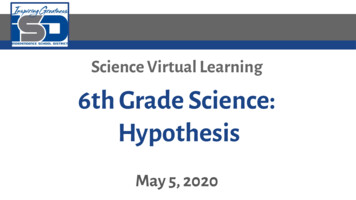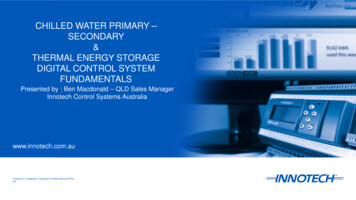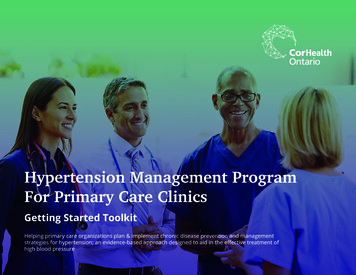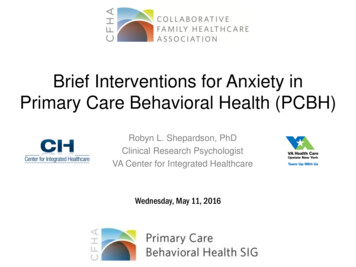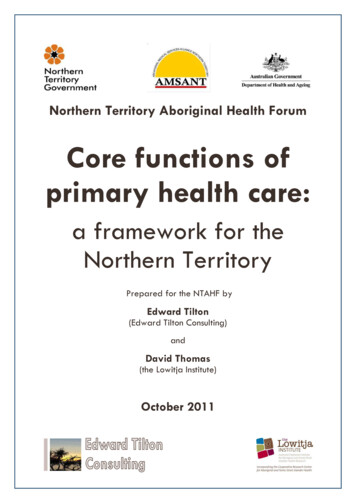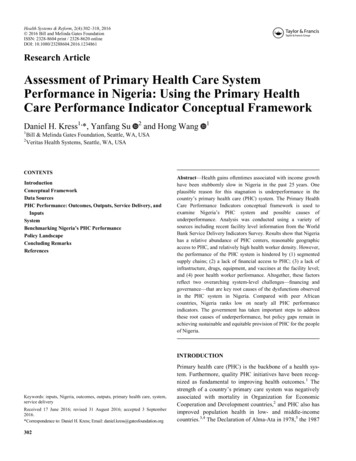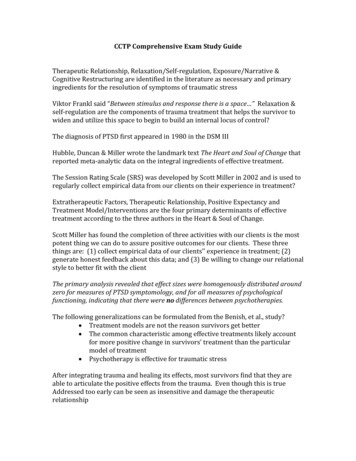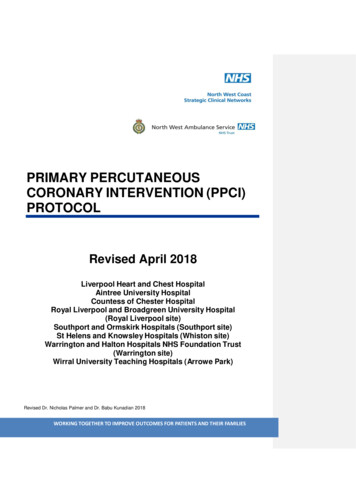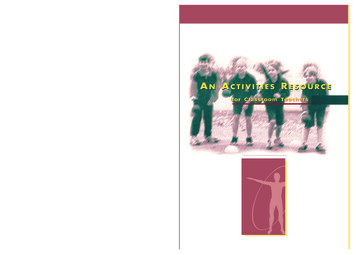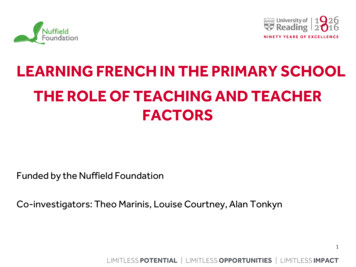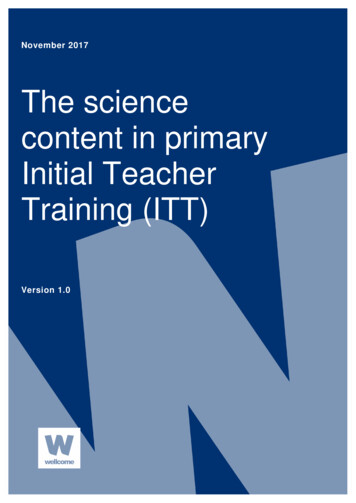
Transcription
November 2017The sciencecontent in primaryInitial TeacherTraining (ITT)Version 1.0
ContentsTable of Contents . 2Foreword . 31.Summarised findings . 42.Introduction . 43.Methodology for this research . 54.3.1.ITT providers . 53.2.Teachers . 5How teachers are prepared to teach science: ITT provider perspectives . 64.1.Entry requirements for all routes into primary teaching . 64.2.Course details . 64.3.SCITT course details (five institutions) . 84.4.University BA and BEd with Qualified Teacher Status (QTS): sixproviders . 94.5.5.6.Observations: the three main training routes . 10The teacher perspective . 115.1.Profile of respondents . 115.2.Observations on teachers’ perspectives . 18Case studies . 196.1.Case study 1: studied science to GCSE, completed a BA in PrimaryEducation in 2013 . 196.2.Case study 2: holds biology AS Level, completed a School Direct PGCEin 2015 206.3.Case study 3: did not study science beyond GCSE – completed theSchool Direct route in 2016 . 226.4.Case Study 4: holds two science A levels, qualified via School Directroute in 2015. 236.5.Case Study 5: did not study science beyond GCSE, qualified via SchoolDirect route in 2016. . 246.6.Key themes from case studies for Wellcome to consider . 257.Conclusions . 268.Appendix 1: Leaders and teachers of primary science . 27Appendix 2: Teacher survey data tables . 29
Wellcome believes that science should be exciting for allyoung people, giving them skills and opportunities toimprove their futures. We are working to transformprimary science education so that every pupil has anexcellent first experience of science.Teachers are the greatest resource we have to ensurethat every pupil experiences great science. Unfortunatelydata from our 2017 ‘State of the Nation’ Report found thata quarter of primary teachers are concerned aboutanswering pupils’ questions about science and most UKschools average less than two hours science teaching1 2each week , .It is vital that all new entrants to primary teaching arewell prepared to teach science.This report describes research we commissioned tobetter understand initial teacher training (ITT) for primaryscience considering information from a range of providersand from recently trained teachers. We are pleased thatthere is a lot of consistency across the ITT routes forprimary science but there are many opportunities toimprove the offer.The timeframe for all primary ITT courses is tight and soproviders cannot cover all of the subject knowledgeneeded for science. More than two thirds of teachers inthis research had not studied science beyond GCSE (orequivalent) and trainees are responsible for identifyingand addressing gaps in their subject knowledge. ITTproviders prioritise training on common misconceptionsthat pupils may develop.have the necessary experience to meet the Teachers’3Standards .ITT providers should ensure that every traineeteaches primary science while on placement andobserves excellent science teaching.4Teachers Standards require teachers to ‘demonstrategood subject and curriculum knowledge’, and be able to‘make accurate and productive use of assessment’.Teachers stated that they would like more ITT coveringpractical experiments and lesson ideas, assessment ofscience, and opportunities to observe excellent teaching.To some extent better subject knowledge, pedagogicalcontent knowledge and a better understanding of howchildren progress their ideas in science would addressthese concerns. It is unlikely that the restricted ITT periodwould be able to cover all of the content necessary forprimary science teaching. The case studies in our reporthighlight how some teachers have addressed theseneeds through ongoing professional development.However when science has low priority in school, it ishard for teachers to access the professional developmentthey need.ITT providers, schools and school mentors shouldguide trainees towards ongoing professionaldevelopment in science to ensure that they are ableto cover the necessary content in their early years inthe profession.All teachers should be participating in regular,science specific professional development tailored totheir needs.Good guidance for trainees is essential to addressweak subject knowledge and misconceptions aboutscience.Several ITT providers reported difficulties in ensuring thattrainees taught science while on placement in schools,although other providers were able to do so. The 2016National Standards recognise clearly the role of schoolsand school-based ITT mentors in ensuring that trainees1Wellcome Trust. ‘State of the Nation’ report of UK primary science education.London: Wellcome Trust; 2017 fthe-nation-report-of-uk-science-education.pdf2Two hours per week is also the international weekly average for primary scienceteaching in similar nations lresults/timss-2015/science/student-achievement/3 Report Title3Department for Education, National College for Teaching and LeadershipNational Standards for school-based initial teacher training (ITT) mentors. ploads/attachment data/file/536891/Mentor standards report s/teachers-standards4As 5 above
This research compared the science content within the main training routes into primary teaching (BA and Bed, SCITT and PGCE)in England and Wales, combining information from training providers with testimony from qualified teachers.It has revealed several themes. Not enough time is dedicated to science on ITT, across all routes. Within any science input, there is a strong focus on practical science. Ensuring their content knowledge is adequate is largely the responsibility of the trainees. ITT providers say that it is not possible to make science teaching mandatory for trainees due to time pressures and timetablingissues going on in schools. In contrast, teachers surveyed for this research do not complain that they lacked the opportunity to teach science while onschool placements. Teachers would like more opportunities to observe good science teaching while on school placements. Teachers report that they did not feel suitably prepared to assess science and notably, providers made little reference to theassessment of science in describing their courses.Wellcome has a strong interest in science education and believes all young people should be confident, active and informedcitizens in science with more progressing into science related careers.5In March 2017, Wellcome, along with a consortium of other organisations involved in science education , agreed a description (seeAppendix 1) of what is expected in respect of leading and teaching science in primary schools. The description recognises that ateacher new in their role may not meet all the expectations but should have a plan to develop the skills and knowledge required.High quality ITT is vital to build teachers’ confidence and prepare them to teach primary science well. But recent changes to teachertraining provision in England presents both a real diversity in the nature of training, as well as challenges for trainees in decidingwhat would be the best route to prepare them for teaching. Research shows that many primary teachers do not have a backgroundin science or may not identify with science themselves, so it is important that initial training prepares them well for their futures.Wellcome commissioned this research to gain a better understanding of: the routes into primary teaching the range of training courses on offer how the courses prepare trainees to teach science the experience of trainees.5Association for Science Education (ASE), Campaign for Science and Engineering (CaSE), Institute of Physics, Institute ofEngineering and Technology, Primary Science Quality Mark, Royal Society, Royal Society of Biology, Royal Society of Chemistryand Wellcome.Report Title 4
During the spring and summer terms in 2017, primary data was collected from two distinct sources: A range of ITT providers, who took part in focussed telephone interviews lasting up to 45 minutes. 85 primary school teachers, who qualified since 2013, completed an online survey and five participated in follow-up interviewsproviding case studies.3.1. ITT providersFourteen different ITT providers engaged with this project, twelve of whom are in England, (six in the South East, three from theSouth West, two from the West Midlands and one from the North East) and two located in Wales. Each of the providers offers arange of routes into teaching. These include: Post Graduate Certificate in Education (PGCE): 10 institutions) Bachelor of Education:4 institutions Bachelor of Arts with Qualified Teacher Status (QTS): 2 institutions6 School Direct : 6 institutions School Centred Initial Teacher Training (SCITT): 5 institutionsThis profile is not representative of all ITT providers in the UK but reflects the different routes into teaching. ITT providers who tookpart, did so on a self-selecting basis.3.2. TeachersTeachers were recruited via a snowball sampling approach and as such should not be considered a representative sample of theteaching population. Teachers did not necessarily attend the ITT providers interviewed. A summary of the online survey data isappended to this report (Appendix 2). The survey was completed by 85 teachers who trained and qualified in the UK since 2013.Follow-up interviews were conducted with five case study subjects – recently qualified teachers whose experiences differed – tooffer first-hand accounts of their experiences of training to teach science and what it is like once they have qualified. Intervieweestook part in the online survey and indicated that they were willing to participate in further research. A short list of candidates wasthen compiled based upon a spread of the routes into teaching and science qualifications to gain a wide range of views to befeatured in the case studies.6School Direct is the salaried version of the SCITT route into teaching. Provision on both courses is therefore very similar.5 Report Title
4.1. Entry requirements for all routes into primary teachingTo access all primary ITT courses in England and Wales, students are most commonly required to have GCSE English, maths andscience at grade C or above (or the equivalent). Two providers required their trainees to hold these qualifications at grade B orabove, while one required a grade B for both English and maths, but a grade C for science. One institution looked for A levelscience (or the equivalent) for those taking a science specialism.In addition, most PGCE providers looked for graduates with a 2:2 degree in any discipline (in combination with the aforementionedgrade C GCSEs in science, maths and English). One PGCE provider required a degree at 2:1 level, while a PGCE offering a7science specialism only accepted graduates who held a degree in a science-related or science subject.One SCITT required trainees to have spent ten days in a school getting experience before they could apply to their ITT course.4.2. Course details4.2.1. PGCE course details: ten institutionsThe PGCE is a university-based course, completed by post-graduates lasting one year. Across the 10 institutions interviewed forthis research, the time dedicated to preparing trainees to teach science ranged from as little as 7.5 hours up to 39 hours over the8course of the academic year based upon the way each provider chose to design their course. The university with the lowestscience content runs three, two-hour taught sessions (of which only one was in a laboratory) and a final 1.5-hour session in aschool. In comparison, the institution with the 39-hour science input provides 13 three-hour sessions.When compared to the other core subjects of maths and English, science gets less teaching time in most institutions: only three outof the ten institutions allocated the same amount of course time to each of the three subjects. Most commonly, science would get60% of the time that either maths or English was afforded and a number of ITT providers stated that this was not sufficient, but thatthe time restrictions did not allow for any alternative.The science content is always taught by people who have a background in both teaching and science, whether that means theyhave a science degree or more commonly have led science in a primary or secondary school.Subject knowledge is something that is both taught and that is left to the trainee teachers to deal with themselves. Two institutionsdescribed a “subject knowledge audit” for science that they run at the start of the year, which is designed to identify gaps in thetrainees’ knowledge. One of these was based on SATs papers, while the other was based on the topics in the national curriculum.78This course awards a General primary (5-11 years) with Science qualificationOther responses included: 8 hours, 12 hours, 15 hours, 20 hours and 36 hours over the course of the year.Report Title 6
When pushed, providers listed the following topics as areas they would most frequently teach: Life processes Electricity Magnetism Light and sound Forces and motion Earth and beyond Materials Rocks and soils Evolution How things workWhere science content is taught, PGCE providers acknowledge that they are unable to cover the entire national curriculum as timedoes not allow for this. Further, they report, the emphasis in the curriculum is more on science-specific pedagogy and enquiry thanon content. However, it is common for providers to base their selection of topics on two things: those things that trainee teachersstruggle with (as identified by the audit exercise where it is used) and those things that children struggle to grasp, though no specificexamples of these were provided.Other factors that inform the selection of topics to cover include those where there are common misconceptions (both amongteachers and children) and those that might boost the confidence of the trainee teachers. Where there are gaps that cannot be filledby taught input, trainees are sent away to research for themselves. Two providers require the trainees to complete another subjectassessment at the end of the year to see if those gaps have been filled, though most do not appear to follow this up. Another,where trainees can select a science specialism, often encourages “micro-teaching”, whereby trainees each take a science topic andgo away and teach it in groups of six to their peers.All interviewed providers put a big emphasis on pedagogy and report that this takes the bulk of the science teaching time on theircourses. Trainees are taught how to teach the national curriculum and how to encourage various approaches to science enquiry,which providers described as: fair testing observing over time identification and classifying pattern-seeking research using secondary sourcesOne provider made reference to assessment for learning, another includes scientific modelling and processes in their syllabus,another spends time demonstrating to students how they can use stories to teach science, while one includes sessions on socialconstructivism. All providers reported that they prioritise pedagogy over content.There is a strong focus on practical science from all PGCE providers. Commonly, all taught sessions have some practical elementsto them. Two providers out of the ten (neither of which offer a science specialism in their ITT) have a laboratory space for thestudents to use, but they were keen to stress that it is not too “high-tech”, as that would not replicate a primary classroom. Studentsare encouraged to look at practical activities from both the pupils’ and teachers’ perspectives. Activities are designed tocontextualise science and to demonstrate the real-world applications of the concepts the students will be teaching. Students oftencarry out their own mini-investigations, trying out different ways to demonstrate something or conduct experiments.Most providers said that they expected their students to teach science while on placements in a school, but that they cannot compelthem to do so, as they rely on the schools facilitating this. There were two exceptions to this: one provider specifies that studentsmust do a number of science-based activities each week, while another (on their science specialist course) said that scienceteaching was compulsory.All PGCE providers check with their students after placements have finished to see what their student teachers had the chance toteach, including finding out how many people taught science and how many did not. Students are encouraged to reflect on theirexperiences of teaching topics as they come up in lectures.7 Report Title
Providers cited a number of barriers to their students being able to teach science. Timetabling was the most frequent: increasingly,schools are “block timetabling” subjects, so it may be possible that they are not teaching any science to their children during astudent placement if it is not scheduled for that period. Providers described the increasing diversity among school types and theirdeparture from the national curriculum making it harder to ensure students get the chance to teach science.When asked about student attitudes to teaching science, PGCE providers said they find that their students are often wary ofscience at the start of the course (though our online survey revealed that confidence levels in English, maths and science wereabout the same for the teachers surveyed, with around two-thirds of respondents saying that they were either quite or veryconfident about each of the three subjects before they began their teacher training – see section 4.2 below). One said that theirstudents would often miss science lectures, as th
there is a lot of consistency across the ITT routes for primary science but there are many opportunities to improve the offer. The timeframe for all primary ITT courses is tight and so providers cannot cover all of the subject knowledge needed for science. More than two thirds of teachers
